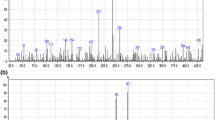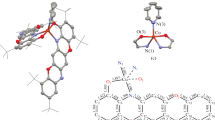Abstract
Prof. Priyadaranjan Rây’s contribution to inorganic chemistry and related disciplines is enormous. His work on the elucidation of valency and structure of coordination compounds through magnetic measurements, proposition of Rây-Dutt twist mechanism and the discovery of inner metallic complexes of higher than second-order made him internationally famous. He first reported the two ligand isomers of thiosulphate ion and designed several organic reagents for the detection and estimation of metal ions. Stabilization of unusual oxidation state of metal ions through coordination with suitable ligand was also his important work. Besides science, he was interested in its history. Scientific activities as well as a brief life-sketch of this Indian stalwart of science is summarized in this present endeavour.
Similar content being viewed by others
Suggested Reading
P C Ray, Life and Experiences of a Bengali Chemist, The Asiatic Society, Calcutta, Vol.1, pp.192–193, 1996 (first published in 1932).
S D Chatterjee, D Banerjea, Priyadaranjan Rây, Biographical Memoirs, Indian National Science Academy, Vol.11 (year of demise: 1982), pp.2–4.
P Rây and H K Sen, The action of hydrazine and hydroxylamine on ferricyanides and a new method for the estimation of hydrazines and ferricyanides, Z. Anorg Chem., Vol.76, p.380, 1912.
Private Communication with Professor (Retd) Rabindra Lal Dutta (Doctoral Student of Priyadaranjan Rây), Department of Chemistry, The University of Burdwan.
P Rây and R M Rây, Metallic compounds of rubeanic acid, J Indian Chem Soc., Vol.3, p.213, 1926.
M Abboudi, A Mosset and J Galy, Metal complexes of rubeanic acid, 3. Large-angle X-ray scattering studies of amorphous copper(II) and nickel(II) complexes, Inorg Chem., Vol.24, p.2091, 1985.
P Rây and A K Chattopadhyay, Die einwirkung von hexamethylenetetramin auf salzlosungen von elementen der dritten gruppe und cin neues verfahren zur quantitativen trennug des eisens von mangan, zink, nickel und kobalt, Z Anorg Chem., Vol.169, p.99, 1928 (in German).
P Rây, Isomeric thiosulphuric acids, Nature, Vol.127, p.856, 1931.
https://www.insa.nic.in/writereaddata/UpLoadedFiles/PINSA/Vol35A_1969_6_Art01.pdf
D M Bose, Magnetism and the structure of some simple and complex molecules, Phil. Mag., Vol.5, No.32, p.1057, 1928.
P Rây and H G Bhar, Magnetic properties of complex compounds and their electronic constitution, J Indian Chem Soc., Vol.5, p.497, 1928.
S S Bhatnagar, B Prakash and A Hamid, Magnetism and molecular constitution of some chromium complexes, J Chem Soc., pp.1428–1434, 1938
S S Bhatnagar, K N Mathur and P L Kapur, Magnetic properties of some substances in absorbed state, Indian J Phys., Vol.3, pp.53–66, 1938.
S S Bhatnagar and R N Mathur, Investigations on the effect of crystalline structure on magnetic susceptibilities by a new magnetic balance based on the principle of interference of light, Phil Mag., Vol.8, pp.1041–1055, 1929.
L Pauling, The nature of chemical bond. III. The transition from extreme bond type to another, J Am Chem Soc., Vol.54, p.988, 1932.
H Taube, Rates and mechanisms of substitution in inorganic complexes in solution, Chem Rev., Vol.50, p.69, 1952.
Nature, Vol.161, p.460, 1948.
P Rây, Complex compounds of biguanides and guanylureas with metallic elements, Chem Rev., Vol.61, p.313, 1961.
P Rây and R K Dutt, Complex compounds of biguanide and bivalent metals, Part IX. Ampholy-tic inner-metallic copper and nickel complexes with naphthylbiguanide o-sulphonic acid and penylbiguanide-p-sulphonic acid and their salts, J Indian Chem Soc., Vol.25, p.563, 1948.
P Rây and N K Dutt, Kinetics and mechanism of racemisation of optically active cobaltic tris biguanide complex, J Indian Chem Soc., Vol.20, p.81, 1943.
R Ghosh, Adhyapak Nikar Kumar Dutt, Jnan-O-Bijnan, Vol.8, p.466, 2014 (in Bengali).
J C Bailer Jr., Some problems in the stereochemistry of coordination compounds, J Inorg Nucl Chem., Vol.8, p.165, 1958.
Private Communication with Professor (Retd) Saktiprosad Ghosh, Department of Inorganic Chemistry, Indian Association for the Cultivation of Science, Kolkata
P Rây and B Sarma, Tetrapositive nickel as alkali nickel periodates, Nature, Vol.157, p.627, 1946.
R D Hall, Combination of sesquioxides with the acid molybdates, J Am Chem Soc., Vol.29, pp.692–714, 1907
H M Powell and A F Wells, Complex anion formation by tervalent elements: The structure of caesium thallic enneachloride, J Chem Soc., pp.1008–1012, 1935.
P Rây and P V Sarkar, Formation and dissociation of some polyhalogen compounds of hydrogen in aqueous solution, J Chem Soc., Vol.121, p.1449, 1922.
A Roy, Shyamadas Chatterjee: Experimenter per excellence!, Resonance, Vol.9, p.762, 2015.
P Rây and S D Chatterjee, A note on the reactions and exchange of active iodine in inorganic system, J Indian Chem Soc., Vol.17, p.524, 1940.
P Rây, History of Chemistry in Ancient and Medieval India, Indian Chemical Society, Kolkata, 1956.
Acknowledgement
Author is thankful to his student Shriman Arnab Chatterjee for his help in generating the line drawings of the chemical structures.
Author information
Authors and Affiliations
Corresponding author
Additional information
Rajarshi Ghosh is associated with post graduation teaching and research in the Department of Chemistry, The University of Burdwan. His research interest covers synthetic coordination chemistry, bio inspired catalysis, biological inorganic chemistry, etc. Besides these, he is also interested in science popularization.
Rights and permissions
About this article
Cite this article
Ghosh, R. Priyadaranjan Rây. Reson 26, 73–87 (2021). https://doi.org/10.1007/s12045-020-1106-8
Published:
Issue Date:
DOI: https://doi.org/10.1007/s12045-020-1106-8




